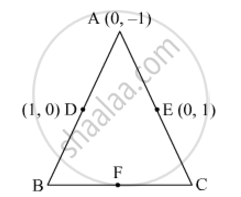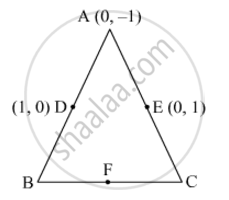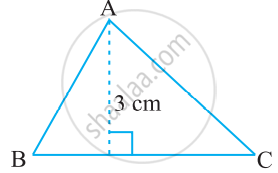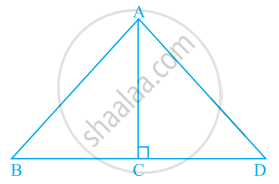Advertisements
Advertisements
प्रश्न
In Fig. 6, ABC is a triangle coordinates of whose vertex A are (0, −1). D and E respectively are the mid-points of the sides AB and AC and their coordinates are (1, 0) and (0, 1) respectively. If F is the mid-point of BC, find the areas of ∆ABC and ∆DEF.

उत्तर

Let the coordinates of B and C be (x2, y2) and (x3, y3), respectively.
D is the midpoint of AB.
So,
`(1,0)=((x_2+0)/2,(y_2-1)/2)`
`=>1 = x_2/2 `
⇒ x2 = 2 and y2 = 1
Thus, the coordinates of B are (2, 1).
Similarly, E is the midpoint of AC.
So,
`(0,1)=((x_3+0)/2, (y_3-1)/2)`
`=>0=x_3/2 `
⇒ x3 = 0 and y3 = 3
Thus, the coordinates of C are (0, 3).
Also, F is the midpoint of BC. So, its coordinates are
`((2+0)/2,(1+3)/2)=(1,2)`
Now,
Area of a triangle = `1/2`[x1(y2−y3)+x2(y3−y1)+x3(y1−y2)]
Thus, the area of ∆ABC is
`1/2[0(1-3)+2(3+1)+0(-1-1)]`
`=1/2xx8`
=4 square units
And the area of ∆DEF is
`1/2`[1(1−2)+0(2−0)+1(0−1)]
`=1/2xx(-2)`
=1 square unit (Taking the numerical value, as the area cannot be negative)
APPEARS IN
संबंधित प्रश्न
Find the values of k so that the area of the triangle with vertices (k + 1, 1), (4, -3) and (7, -k) is 6 sq. units.
Find the area of the triangle formed by joining the mid-points of the sides of the triangle whose vertices are (0, -1), (2, 1) and (0, 3). Find the ratio of this area to the area of the given triangle
Show that points A (a, b + c), B (b, c + a), C (c, a + b) are collinear.
The area of a triangle is 5 sq units. Two of its vertices are (2, 1) and (3, –2). If the third vertex is (`7/2`, y). Find the value of y
If the points P(-3, 9), Q(a, b) and R(4, -5) are collinear and a+b=1, find the value of a and b.
Find BC, if the area of the triangle ABC is 36 cm2 and the height AD is 3 cm.

The area of a triangle with vertices (–3, 0), (3, 0) and (0, k) is 9 sq.units. The value of k will be ______.
Find the value of m if the points (5, 1), (–2, –3) and (8, 2m) are collinear.
The base and the corresponding altitude of a parallelogram are 10 cm and 3.5 cm, respectively. The area of the parallelogram is 30 cm2.
In the given figure, ratio of the area of triangle ABC to the area of triangle ACD is the same as the ratio of base BC of triangle ABC to the base CD of ΔACD.

